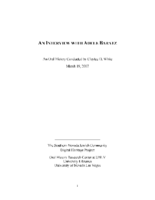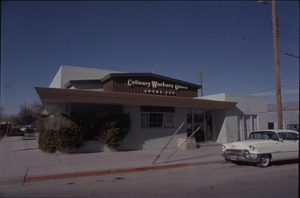Search the Special Collections and Archives Portal
Search Results

Transcript of interview with Adele Baratz by Steve McClenachan, March 3-4, 1979
Date
Archival Collection
Description
Interview with Adele Baratz by Steve McClenachan on March 3 and 4, 1979. In this interview, Baratz talks about growing up in Las Vegas and her her schooling. She graduated from Las Vegas High School in 1944, and discusses the rationing that took place during World War II. She went to Maryland for nursing school and returned to Las Vegas in 1947. She describes some of the hotels and casinos, and tells the story of her father trading property for an automobile in 1935. She also recalls the building of Hoover Dam, swimming in local pools, and going to Mount Charleston in the winter. The interviewer asks her about travel between Las Vegas and California and the impact of Atlantic City on Las Vegas tourism. Baratz then talks about her nursing career and starting a re-certification program in 1974 and the different hospitals in the area.
Text

Transcript of interview with Adele Baratz by Claytee D. White, March 19, 2007
Date
Archival Collection
Description
Interview with Adele Baratz by Claytee White on March 19, 2007. In this interview, Baratz talks about her parents who came to the United States as teenagers from Russia and eventually settled in Las Vegas after a short time in California. She discusses the Jewish community in Las Vegas when she was growing up, and her father's job selling bootlegging supplies, then as a real estate broker, then as a bar owner. Baratz attended the Fifth Street Grammar School, which was built after a fire destroyed the original school, and Las Vegas High School. As a teenager, she worked at Nellis as a messenger and in the rations department, then went to nursing school in Baltimore at Sinai Hospital. She talks about her father's bar, "Al's Bar," that was popular with Union Pacific Railroad workers, and how the bar was forced out for the building of the Golden Nugget. Baratz recounts where her family lived, the growth of the Jewish community, and building the first synagogue on Carson Street.
Text
Audio clip from interview with Adele Baratz, 2007
Date
Archival Collection
Description
In this clip, Adele Baratz talks about her parents' experiences in real estate and business ownership in the 1920s and 1930s in Las Vegas.
Sound

Glass slides of aerial views, buildings, and construction sites, Las Vegas (Nev.), 1950s-1960s (tray 2 of 3)
Date
Archival Collection
Description
Slides collected by the Culinary Workers Union Local 226 depict Las Vegas during the 1950s and the 1960s. Individual photos show aerial views of the city, construction sites, residential streets, and buildings such as union offices, shopping centers, banks, schools, houses of worship, etc. Other important sites depicted include McCarran Airport, the Las Vegas Convention Center, and the University of Nevada, Las Vegas. A number of slides are illustrated graphs charting growth in the city between 1954 and 1964. Tray 2 of 3. The original slides were retained by the Union.Arrangement note: Series V. Glass slides
Image

Glass slides of the Culinary Workers Union Local 226 offices and various local buildings, Las Vegas (Nev.), 1950s-1960s (tray 3 of 3)
Date
Archival Collection
Description
Slides collected by the Culinary Workers Union Local 226 depict the Union's offices and other buildings in Las Vegas during the 1950s and the 1960s. Images include exterior views of the Union's building, construction sites, hotels, and restaurants, and aerial shots of Las Vegas. Also included are images depicting activities inside an office, likely the Culinary Union's office. Tray 3 of 3. The original slides were retained by the Union.Arrangement note: Series V. Glass slides
Image

Photographs of Frontier Strike: Desert Solidarity, Solidarity March, Culinary Union, Las Vegas (Nev.), 1990 December 05 (folder 1 of 2)
Date
Archival Collection
Description
Arrangement note: Series I. Demonstrations, Subseries I.A. Frontier Strike
Image

Photographs of First rally of the Frontier Strike, Culinary Union, Las Vegas (Nev.), 1991 August 07 (folder 3 of 3)
Date
Archival Collection
Description
Culinary Union workers march in the first rally of the Frontier Strike on August 7, 1991 in Las Vegas, Nevada. Additionally, images show police officers on bicycles and Culinary Union workers crowding around Jim Arnold, former secretary-treasurer of the Culinary Workers Union. The Frontier marquee is depicted and reads, "Welcome teachers & ironworkers, bottled beer 25 cents 2pm Aug. 7 .. 10"Arrangement note: Series I. Demonstrations, Subseries I.A. Frontier Strike Site name: Frontier Hotel and Casino
Image

Photographs of Frontier Strike: Ironworkers and classified workers, Culinary Union, Las Vegas (Nev.), 1991 August 07 (Folder 1 of 1 )
Date
Archival Collection
Description
Culinary Union workers march in protest at the Frontier Hotel and Casino on August 7, 1991. Strikers have signs depicting Culinary Local 226 and Bartenders Local 165. Images also show secretary-treasurer of the Culinary Workers Union, Jim Arnold speaking on an outdoor stage. The Frontier marquee is depicted and reads, "Welcome Boilermakers, players bar 10am to 10pm, boilermakers 50 cents, bottle beer 25 cents." Protest signs read, "Conquering the Frontier, Culinary Local 226, Bartenders Local 165" and "Margaret Elardi, bargain in good faith."Arrangement note: Series I. Demonstrations, Subseries I.A. Frontier Strike Site name: Frontier Hotel and Casino
Image

Photographs of Ironworkers and classified workers at Frontier Hotel, Culinary Union, Las Vegas (Nev.), 1991 August 07 (folder 1 of 1)
Date
Archival Collection
Description
Culinary Union workers strike at the Frontier Hotel and Casino on August 7, 1991. Secretary-treasurer of the Culinary Workers Union, Jim Arnold, and civil rights activist, Jesse Jackson are shown speaking on stage. Photographs also show police officers and travel buses on site. A large banner is partly shown, reading "Welcome iron workers... iron workers of the state of California and vicinity including..." Protest signs read, "Conquering the Frontier, Culinary Local 226, Bartenders Local 165." The Frontier marquee is depicted and reads, "Welcome teachers & ironworkers, bottled beer 25 cents 2pm Aug. 7 .. 10"Arrangement note: Series I. Demonstrations, Subseries I.A. Frontier Strike Site name: Frontier Hotel and Casino
Image

Photographs of Frontier Strike: First Rally of the Frontier Strike, Las Vegas (Nev.), 1991 August 07 (Folder 1 of 3)
Date
Archival Collection
Description
Culinary Workers Union strikers rally outside the Frontier Hotel and Casino with signs that say, "CONQUERING THE FRONTIER" and "MARGARET ELARDI BARGAIN IN GOOD FAITH". The Frontier marquee reads: "Welcome teachers & ironworkers, bottled beer 25 cents 2pm Aug. 7 .. 10"Arrangement note: Series I. Demonstrations, Subseries I.A. Frontier Strike Site name: Frontier Hotel and Casino
Image
